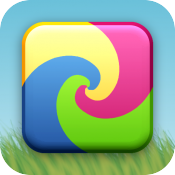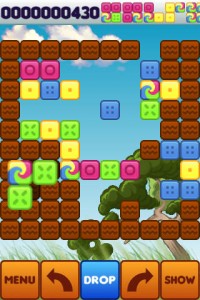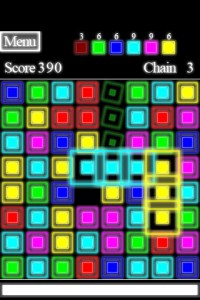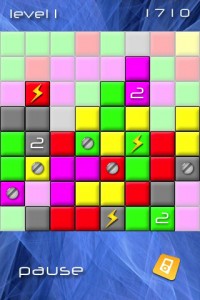In part because I’ve only just found out that someone beat Threes! for the first time, I’m finally going to write a post about my game Slide Quest.
But it won’t (just) be about Slide Quest… (Feel free to skip to the list of my three favorite Threes!-inspired games below.)
Okay, first off, I’ve never publicly talked about Slide Quest before. There are several reasons for this, but namely I’ve been embarrassed by it. I actually never meant to release it. (This is hard to believe, I know, but in some past versions of iTunes Connect — apple’s publishing webapp — you had to set a release date for your app. If you started creating the app in there, but you didn’t know if you wanted to publish it, one technique was to just set the release date to some far off date in the future. I did this, but then that date passed, and the app was released. No fanfare, I didn’t even get notified, or if I did I was too busy with client work to notice.) Anyway, when I found out it was released, it was to a few pretty terrible reviews. (It was basically not much more than a prototype.) I decided I’d rather it was out there than not, but I felt dumb, and basically never promoted it in any way.
I was also embarrassed because of all the issues around whether or not games inspired by Threes! are clones. Threes! was famously cloned very soon after its release, with a game called 1024 appearing in the app store only three weeks after Threes!. This was exacerbated by the release of another game (called 2048) by an 18-year-old developer who claimed he’d never even seen Threes!, and had written his game based on 1024. 2048 was made in javascript, in a weekend, and released for free on github. It proved to be extremely popular, in part because there were a ton of versions of it that appeared for free, often with Ads. (Threes! later went “free with IAP”.) 2048 was also an easier game. It’s wasn’t as punishing as Threes!, and a casual player was more likely to hit upon a winning strategy.
The point is, within a month, there were probably hundreds of games inspired by Threes!, both in the app store and elsewhere. For more about Threes! and clones, you should read the Polygon writeup, but also read the post by the developers of Threes!, where they also post all their correspondence (emails) during the game’s creation. That post is rather heart-breaking, but the email archive is actually a pretty amazing resource for aspiring game developers.
Anyway, I loved Threes!, and played the hell out of it at launch. I bought the tshirt. At some point I started thinking about an RPG with the same “swipe mechanics” as Threes!, and the thought kept me up at night. I too put together a prototype of that game in a weekend. That game was initially called RPGeez, but eventually I changed the title to Slide Quest.
There are several subtle differences (aside from the obvious aesthetic ones) between Threes! and 2048. In Threes! a swipe only moves each of the tiles on the board one space; in 2048, they move until they can’t move any farther. There are of course other differences, but this is the main thing.
With Slide Quest, the main mechanical difference is that there is a character on the board. That character is “you”, and you slide around the board with every swipe. You have a level, and you level up if you attack (combine with) a monster on the board that is the exact same level as you. You can attack and defeat lower level monsters without effect. Higher level monsters just block the board and lead to (eventual) game over. Like 2048, Slide Quest is definitely much “easier” than Threes!, but it does have one more interesting twist, in that every 33 levels, the algorithm for what level monsters spawn on the gameboard changes, getting more difficult.
Over the 3.3 years since Threes! was released, I’ve sometimes taken note when I see other games inspired by Threes!, mostly because I’m curious to see how they tweak the mechanics.
Here is a list of three Threes!-inspired games that I quite enjoy:
Stencilsmith, by Nicholas Sepi Jr. — This game is probably easiest to describe as Threes! meets Minecraft, though much simpler than that makes it sound. Essentially, there are pickaxes that need to combine with land to make materials, and the materials can then combine with pickaxes to make more powerful pickaxes. There are also swords, which need to combine with materials before they can then combine with enemies to take them off the board. You have three hearts (in the main game mode), and when you combine an enemy with something not a sword, it takes a heart.
SideSwype, by Radiangames} — This game combines Threes!-style swiping and match-3 mechanics. I really enjoyed it, and it’s got an elegant graphical style. Incidentally, it’s also by the developer of Slydris, which is an amazing game.
Puzzle Chips, by Curt Stein — Curt Stein created one of my early app store favorites called DropOut. In this poker-chip-themed take on the genre, each tile is a stack of chips. When the stack gets tall enough, it can be tapped to remove it from the board. So basically the numbers don’t really combine or increase, but as you play, chips that are worth more will spawn more frequently.
In a post back in 2014, I talk about small grid games, and said that 2048 was my favorite threes-inspired game. But in my memory of the time, I didn’t actually play that much of 2048, I was actually just really excited to surf the many forks of it that added different mechanics. Now when I try and view forks on github (it says there are 15,037), it just gives me the error “Too many forks to display.”
Please let me know (either here in the comments, or over on my twitter) if you have other Threes! inspired games that you like.
UPDATE (2019-06-13): Adding some screenshots and removed app store link as the game hasn’t been live for at least a while now.
Also worth noting that Twinfold by Kenny Sun does what I wanted to do with SlideQuest WAY better than I did. Basically just adds a ton of other elements, and is actually more of a “real” game than SlideQuest ever was, while basically being a similar progression-based high score game. Highly recommended.

 Interested, as I am, in the family tree of puzzle games, when I wrote up my
Interested, as I am, in the family tree of puzzle games, when I wrote up my  The gameplay is at your own pace, and you do see a queue of the next few pieces, so you can plan ahead to maximize your strategic brain burning. When picking up the game again after all this time, I found it didn’t quite hold my attention the same way 1010! and Hex FRVR have for so many hours. I’m not honestly sure why that is the case. The complexity is about the same, maybe a tiny bit higher, due to the color matching rather than line-making, but I found myself playing the game a lot slower than I do those others.
The gameplay is at your own pace, and you do see a queue of the next few pieces, so you can plan ahead to maximize your strategic brain burning. When picking up the game again after all this time, I found it didn’t quite hold my attention the same way 1010! and Hex FRVR have for so many hours. I’m not honestly sure why that is the case. The complexity is about the same, maybe a tiny bit higher, due to the color matching rather than line-making, but I found myself playing the game a lot slower than I do those others.
